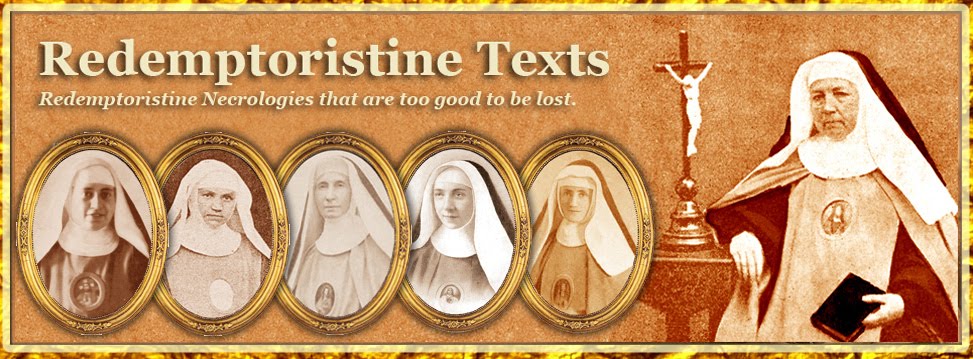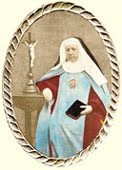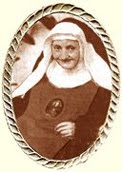Born Catherine Merckelbach
Sister Maria-Seraphica, [1] in the world Catherine Merckelbach, was born on 7th April 1810 at Wittem, in Dutch Limburg. She was the youngest of the twelve children of Simon Merckelbach, Mayor of the village and the local judge, and Elisabeth Schervier. She lost her father at the age of two; but the intense and pious education that she received from her mother compensated her for this dreadful loss. Moreover, this truly Christian mother exercised the most happy influence over all her children: they were all good Christians; two of them became excellent secular priests, one the Dean of Galoppe, near Wittem, and the other the parish priest of Montzen, in the Diocese of Liege.
Young Catherine, though endowed with precious qualities, was not however without her faults. Her stubbornness went so far one day that she threw the food she had received from her mother onto the ground. An unexpected reprimand punished this misdemeanour. “It would be better,” a solemn voice suddenly said, “it would be better for this child to die rather than remain so capricious.” It was the voice of Catherine’s brother, who had succeeded his father in the position of judge. This severe utterance, pronounced in the presence of the young girl and her mother, made the deepest impression on Catherine. Quite resolved not to die, she became distinguished from then onwards for the politeness of her manners.
And then precious virtues germinated in her heart and promised a wonderful future. A tender piety, a filial fear of God that led her to carefully avoiding the least faults, a sincere and true modesty, joined to her other qualities, soon attracted the eyes of the world to her, but she remained deaf to the advances that were made to her. In 1834, a mission preached by the Redemptorist Fathers at Montzen determined her to give herself totally to God. Finally in 1837, after the death of her mother, she left her own country in spite of the resistance of her family, and entered the Convent of the Redemptoristines in Vienna. This was on 19th October. The 7th January 1839 was the day of her vesting. On 9th January following, she made her profession together with her niece Marie-Xaveria.
* * * * *
Sister Maria-Seraphica began her religious career under the direction of the Venerable Father Joseph Passerat, who was then residing in Vienna. This is to say that she gave herself very particularly to living a life of prayer. Her tender love for the divine Redeemer and His most holy Mother maintained this sweet spirit in her, a true prerogative of the Daughters of Saint Alphonsus, and thence led her efficaciously to the exercise of the virtues. Prayer, the common life, fraternal charity, these three foundations of the religious life, were especially dear to her heart, but to believe her contemporaries (and their witness is impartial), she truly excelled in all the virtues. Only an excessive over-sensitivity of conscience which degenerated into scruples and prevented her from ever becoming Superior threw a light shadow over this scene. But on the other hand, her extraordinary purity of heart profoundly amazed all those who knew her, and one day it even evoked this exclamation from a holy priest: “I have never met so pure a soul!”
Upon this admirable foundation, the fruit of the predilections of the Lord, Sister Maria-Seraphica quietly, but without ever relaxing, elevated her spiritual edifice. Humble and loving humiliation, obliging and sweet towards all her Sisters, always ready for anything and also to take on the tasks that were asked of her, loving to suffer and often without seeking to understand why, she was able to practise the most difficult virtues in an extremely simple and, might one say, monotonous life. She attracted everyone’s regards, while fleeing in horror from any human praise, and was able to deflect the most severe criticism. Was it not true that her fervour, or rather we may say, that her holiness was indeed so extraordinary that it merited from the Sisters eulogies such as the following? – Sister Maria-Seraphica was a mirror of all the virtues.” – “If she was not a saint, I do not know how the saints could have been,” and this other one, more decisive still: “Sister Maria-Seraphica was the living Rule. If you want to know what she did, how she did it, and what she did not do, just read our holy Rules.”
We can add some other features to this scene. Suffering, both interior and exterior, was the assiduous companion of Sister Maria-Seraphica; and she found in the cross one kind of food for her love. She searched for another in the pious dialogues that Saint Alphonsus recommends so vividly to religious souls. Ordinarily little given to talking, she became eloquent whenever anyone broached the subject of the divine love; her looks then betrayed an indefinable happiness, and the picturesque expression of one of the Sisters sums it all up for us: “all the registers of her interior organ seemed drawn in an instant.”
* * * * *
The task of Superior excepted, our good Sister several times fulfilled the most important and difficult tasks in the monastery. She did them to the satisfaction of all the Sisters, as her charity was immense. And so she spent the years of her religious life, first at Vienna, and then after the revolution of 1848, in the new Monastery of Marienthal, near to her birthplace. It was there that the last fifteen years of her life were spent. From 1857, a cancerous tumour in her breast made her suffer some cruel agonies. The illness did nothing but get worse, and death was soon approaching rapidly. On 29th June 1865, they had to give the invalid the last sacraments. Before doing so, the famous Father Bernard Hafkenscheid, Redemptorist, gave the Sisters a sermon in which he was not afraid to propose Sister Maria-Seraphica as a model of religious perfection, and notably, of a marvellous charity. Then he brought the Holy Viaticum to the invalid and fortified her with Extreme Unction. She received these two sacraments with the most fervent piety. She went on living until the 23rd August, giving all her Sisters the most touching examples of resignation. On that day, the Lord conveyed her to the eternal wedding.
After her death, from the hearts of her fellow Sisters and all those who had known her, a chorus of praises was raised. They can be summarized in the words of a former Sister of Ried: “This humble Sister, under the appearance of the most pleasing simplicity, constantly practised all the virtues so well that we may say of her: She has done all things well.” From then on they began to invoke her confidently. One converse novice had become almost entirely deaf following a very severe fever. Praying before the body of the deceased, she asked for her help, and was not afraid to put Sister Maria-Seraphica’s finger into her deaf ear. A noticeable improvement was produced immediately, and the following morning, after experiencing severe pains in her head after communion, she was completely cured.
A Franciscan Sister from Aix-la-Chapelle suffered for six months from a feebleness of nerves and stomach that resisted all the efforts of medicine. Following a novena that she made to Sister Maria-Seraphica, and swallowing a little piece of her vestment every day, she found herself not just cured of her illness, but suddenly as robust as if she had never suffered. The doctor himself recognized this fact as humanly inexplicable.
Many similar facts, both spiritual and temporal, were recollected by the companions of the pious deceased, and they continue always, in the Monastery of Marienthal, to confidently invoke the humble Sister whom the Lord glorified in so touching a manner.
Young Catherine, though endowed with precious qualities, was not however without her faults. Her stubbornness went so far one day that she threw the food she had received from her mother onto the ground. An unexpected reprimand punished this misdemeanour. “It would be better,” a solemn voice suddenly said, “it would be better for this child to die rather than remain so capricious.” It was the voice of Catherine’s brother, who had succeeded his father in the position of judge. This severe utterance, pronounced in the presence of the young girl and her mother, made the deepest impression on Catherine. Quite resolved not to die, she became distinguished from then onwards for the politeness of her manners.
And then precious virtues germinated in her heart and promised a wonderful future. A tender piety, a filial fear of God that led her to carefully avoiding the least faults, a sincere and true modesty, joined to her other qualities, soon attracted the eyes of the world to her, but she remained deaf to the advances that were made to her. In 1834, a mission preached by the Redemptorist Fathers at Montzen determined her to give herself totally to God. Finally in 1837, after the death of her mother, she left her own country in spite of the resistance of her family, and entered the Convent of the Redemptoristines in Vienna. This was on 19th October. The 7th January 1839 was the day of her vesting. On 9th January following, she made her profession together with her niece Marie-Xaveria.
* * * * *
Sister Maria-Seraphica began her religious career under the direction of the Venerable Father Joseph Passerat, who was then residing in Vienna. This is to say that she gave herself very particularly to living a life of prayer. Her tender love for the divine Redeemer and His most holy Mother maintained this sweet spirit in her, a true prerogative of the Daughters of Saint Alphonsus, and thence led her efficaciously to the exercise of the virtues. Prayer, the common life, fraternal charity, these three foundations of the religious life, were especially dear to her heart, but to believe her contemporaries (and their witness is impartial), she truly excelled in all the virtues. Only an excessive over-sensitivity of conscience which degenerated into scruples and prevented her from ever becoming Superior threw a light shadow over this scene. But on the other hand, her extraordinary purity of heart profoundly amazed all those who knew her, and one day it even evoked this exclamation from a holy priest: “I have never met so pure a soul!”
Upon this admirable foundation, the fruit of the predilections of the Lord, Sister Maria-Seraphica quietly, but without ever relaxing, elevated her spiritual edifice. Humble and loving humiliation, obliging and sweet towards all her Sisters, always ready for anything and also to take on the tasks that were asked of her, loving to suffer and often without seeking to understand why, she was able to practise the most difficult virtues in an extremely simple and, might one say, monotonous life. She attracted everyone’s regards, while fleeing in horror from any human praise, and was able to deflect the most severe criticism. Was it not true that her fervour, or rather we may say, that her holiness was indeed so extraordinary that it merited from the Sisters eulogies such as the following? – Sister Maria-Seraphica was a mirror of all the virtues.” – “If she was not a saint, I do not know how the saints could have been,” and this other one, more decisive still: “Sister Maria-Seraphica was the living Rule. If you want to know what she did, how she did it, and what she did not do, just read our holy Rules.”
We can add some other features to this scene. Suffering, both interior and exterior, was the assiduous companion of Sister Maria-Seraphica; and she found in the cross one kind of food for her love. She searched for another in the pious dialogues that Saint Alphonsus recommends so vividly to religious souls. Ordinarily little given to talking, she became eloquent whenever anyone broached the subject of the divine love; her looks then betrayed an indefinable happiness, and the picturesque expression of one of the Sisters sums it all up for us: “all the registers of her interior organ seemed drawn in an instant.”
* * * * *
The task of Superior excepted, our good Sister several times fulfilled the most important and difficult tasks in the monastery. She did them to the satisfaction of all the Sisters, as her charity was immense. And so she spent the years of her religious life, first at Vienna, and then after the revolution of 1848, in the new Monastery of Marienthal, near to her birthplace. It was there that the last fifteen years of her life were spent. From 1857, a cancerous tumour in her breast made her suffer some cruel agonies. The illness did nothing but get worse, and death was soon approaching rapidly. On 29th June 1865, they had to give the invalid the last sacraments. Before doing so, the famous Father Bernard Hafkenscheid, Redemptorist, gave the Sisters a sermon in which he was not afraid to propose Sister Maria-Seraphica as a model of religious perfection, and notably, of a marvellous charity. Then he brought the Holy Viaticum to the invalid and fortified her with Extreme Unction. She received these two sacraments with the most fervent piety. She went on living until the 23rd August, giving all her Sisters the most touching examples of resignation. On that day, the Lord conveyed her to the eternal wedding.
After her death, from the hearts of her fellow Sisters and all those who had known her, a chorus of praises was raised. They can be summarized in the words of a former Sister of Ried: “This humble Sister, under the appearance of the most pleasing simplicity, constantly practised all the virtues so well that we may say of her: She has done all things well.” From then on they began to invoke her confidently. One converse novice had become almost entirely deaf following a very severe fever. Praying before the body of the deceased, she asked for her help, and was not afraid to put Sister Maria-Seraphica’s finger into her deaf ear. A noticeable improvement was produced immediately, and the following morning, after experiencing severe pains in her head after communion, she was completely cured.
A Franciscan Sister from Aix-la-Chapelle suffered for six months from a feebleness of nerves and stomach that resisted all the efforts of medicine. Following a novena that she made to Sister Maria-Seraphica, and swallowing a little piece of her vestment every day, she found herself not just cured of her illness, but suddenly as robust as if she had never suffered. The doctor himself recognized this fact as humanly inexplicable.
Many similar facts, both spiritual and temporal, were recollected by the companions of the pious deceased, and they continue always, in the Monastery of Marienthal, to confidently invoke the humble Sister whom the Lord glorified in so touching a manner.
Footnotes
[1] See “The Life and Virtues of Sister Maria Seraphica of the holy Five Wounds written by one of her fellow Sisters” [Leben und Tugenden der Schwester Maria Seraphika von den hl. Fünf Wunden beschrieben von einer ihrer Mitschwestern], Marienthal 1884.
This necrology is translated from Fleurs de l'Institut des Rédemptoristines by Mr John R. Bradbury. The copyright of this translation is the property of the Redemptoristine Nuns of Maitland, Australia. The integral version of the translated book will be posted here as the necrologies appear.




























